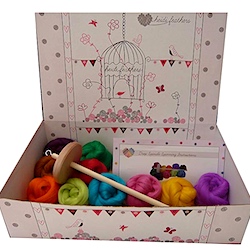Sometimes you have a great idea, but as you follow it through, things just don't feel right. The end result may still be a good one, if not what you'd originally intended.
This is a case of something feeling right and being enjoyable right from the start. And I think with any craft, the journey is as important as arriving.
Sunsets can contain an amazing variety of colours and I've long had the idea of putting those colours into a yarn. This is the picture I've found to work from:

In case my scribblings aren't clear, the colours I've chosen are: cheesecake 10%, liquorice 20%, tangerine 30%, raspberry 10%, blueberry 30% (Before I started spinning, I changed blueberry to 20% and added 10% lagoon, a deeper blue).
(it was late evening when I started this and so the colours in the photo and the dyed fibre don't look as vibrant as they really do.)
This is the first time I've bothered to weigh out fibre for spinning; it wasn't much trouble and now I'll know exactly how much I've spun (at least in weight) before I start to ply.

I found myself drawing the fibres out straight (Worsetead) and using a medium to long draw which seemed to suit both me and my merino.
As I was working I was mulling over the 'navaho or 2-ply' question. I don't want to muddy these colours, but at the same time I'm not sure I would like the strong self-striping effect I'd get from navajo. Three ply might be better for socks, but might be too chunky, so two it probably will be. I'll try a sample of each method before I ply it all.
So... I've decided on colour and fibre first, let the yarn dictate the spinnning method, and failed to decide on a pying method; all of which goes right against
Judith Mackenzie McCuin's holistic approach which is to plan it all carefully beforehand!
Having nearly finished Lolita Legs and learned to cast-on at the toe and turn a heel, I'd love to make a pair of socks, and I think these colours will be perfect. I have read that 100% wool isn't perfect for hard-wearing sock yarn, but I notice that the walking gear manufacturers are singing the praises of wool for its quaities such as thermal properties, elasticity, 'wicking' environmental friendliness, as if they've invented a new high-tech material! ('
smartwool' seem to be a selectively-bred fine merino).

I'm using the turkish spindle and lovin' it. It spins really well, is really light and I love the little ball of singles that grows in the middle.
As I mentioned, it was late evening and so the tea naturally became wine and I soon got into the rhythm - twist, sip, draw, twist, sip, draw, twist, sip, draw, wind on...





















